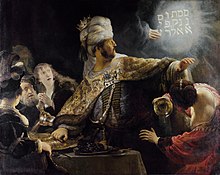Belsatzar

Belsatzar / Belsazar is a ballad by Heinrich Heine from 1820. It belongs to the cycle of poems Junge Leiden , written between 1817 and 1821 and published in 1827 in the Book of Songs . The poem reproduces a slightly modified biblical story from the book of Daniel : Belshazzar , the king of Babylon , blasphemes Jehovah , the God of the Jews. Then a mysterious flame writing appears on the wall. In the biblical model, the prophet Daniel reveals the menetekel as God's judgment and prophesies the ruler's imminent downfall. In Heine's version, however, the prophet does not appear and the meaning of the enigmatic script remains incomprehensible. Nevertheless, Heine's Belsatzar is killed by his own servants.
text
Belsatzar
Midnight was drawing nearer;
Babylon lay in silent rest.
Only upstairs, in the king's castle,
there is a flicker, there is a noise from the king's train,
there, up there, in the king's hall,
Belsatzar held his king 's meal .
The servants sat in shimmering rows,
and emptied the cups with sparkling wine.
The cups rattled, the servants shouted;
So it sounded right to the stubborn king.
The king's cheeks glow;
In the wine he grew bold courage.
And courage tears him blindly;
And he blasphemed the deity with sinful words.
And he boasted impudently and blasphemed wildly;
The band of servants shouts applause.
The king called with a proud look;
The servant hurries and returns.
He wore a great deal of gold equipment on his head;
It was stolen from Jehovah's temple.
And the king took hold of
a holy cup filled to the brim with a wicked hand .
And he hastily empties it to the bottom,
And calls out loud with foaming mouth:
Jehovah! I announce mockery to you forever, -
I am the King of Babylon!
But as soon as the cruel word died away,
the king was secretly afraid in his bosom.
The piercing laughter fell silent;
It was dead silence in the hall.
And see! and see! on a white wall It
came out like a human hand;
And wrote and wrote
letters of fire on the white wall , and wrote and faded.
The King sat there
with a staring look, His knees trembling and pale as death.
The band of servants sat cold and gray,
And sat very still, made no sound.
The magicians came, but none of them understood how
to read the flaming writing on the wall.
But that night Belsatzar was
killed by his servants.
Emergence
It is believed that Heine after a reading of the translated into German poem Vision of Belshazzar of Lord Byron wrote his romance.
shape
The poem consists of 21 stanzas with two verses each, which are consistently held in pair rhymes . The meter , usually an iambic four-meter , ends with a male cadence . Exceptions - with anapest instead of the expected iambs - are the fourteenth and fifteenth verse in the King against God presumptuously ( "And he läs shouldering the God standardized with sün DIGEM word // And he. Brus tet is cheeky , and blasphemes wild") as well as stanzas 10, 11 and 12.
interpretation
The background to the plot is Dan 5 EU .
literature
- Ingo Müller: The Flickering of Signs: Identity and Alterity in Heinrich Heine's Belsatzar Romance. In: Journal for German Studies, ed. by Claudia Stockinger, Mark-Georg Dehrmann, Alexander Kosenina and Ulrike Vedder, Bern a. a. 2020, Vol. 30, H. 2, pp. 437-454.
- Ingo Müller: Mask play and soul language. On the aesthetics of Heinrich Heine's book of songs and Robert Schumann's Heine settings (= Rombach Wissenschaft), 2 volumes, Baden-Baden 2020. Volume 1: Heinrich Heine's poetry aesthetics and Robert Schumann's song aesthetics , ISBN 978-3-96821-006-3 . Volume 2: Heinrich Heine's book of songs and Robert Schumann's Heine settings , Baden-Baden 2020, ISBN 978-3-96821-009-4 , pp. 466–505.
- Helmut Christmann: Heinrich Heine. Belshazzar . In: Paths to the Poem. II: Interpretation of ballads, ed. by Rupert Hirschenauer and Albrecht Weber, Munich and Zurich 1963, pp. 261–266.
- Kurt Abels: "Belsatzar" by Heinrich Heine. In: Poems from Seven Centuries: Interpretations, ed. and edited by Karl Hotz, Bamberg 1987, pp. 124-128.
- Katharina Mommsen: Heine's lyrical beginnings in the shadow of the Carlsbad resolutions . In: Knowledge from Experience: Work Terms and Interpretations Today. Festschrift for Herman Meyer for his 65th birthday, ed. by Alexander Bormann, Tübingen 1976, pp. 453-473.
- Kurt Groom: Heinrich Heine. Belshazzar . In: Die Deutsche Ballade: Ways to their interpretation on the intermediate level, ed. by Kurt Bräutigam, Frankfurt a. M. 5 1971, pp. 90-98.
- Peter von Matt: Blast effect and sophistication. In: Ders., The Suspicious Splendor. About poets and poems. Munich 2 2005, pp. 119–121.
- Winfried Freund: Heinrich Heine: Belshazzar. In: Ders., The German Ballade. Theory, Analyzes, Didaktik, Paderborn 1978, pp. 73-80.
- Winfried Woesler: To Heinrich Heine's Belsatzar . In: Poems and Interpretations. German ballads, ed. by Gunter E. Grimm, Stuttgart 1988, pp. 180-195.
reception
Robert Schumann set the poem to music under Op. 57. Belsatzar belongs with the poems The Loreley and The Grenadiers to the most famous ballads of the poet.
The Germanist Oliver Bernhardt also gives a consideration of the flaming writing on the wall in his work 5300 Jahre Schrift on pages 142-145 (Michaela Böttner, Ludger Lieb , Christian Vater, Christian Witschel (eds.): 5300 Jahre Schrift . Wunderhorn, Heidelberg 2017, ISBN 978-3-88423-565-2 ( Open Access ). )
Web links
Individual evidence
- ↑ Heinrich Heine: Book of songs . Insel 1981, ISBN 3-458-14792-6 .
- ^ Lydia Fritzlar: Heinrich Heine and the Diaspora. The journalist in the cultural space of the Jewish minority . Gruyter 2012, p. 110.